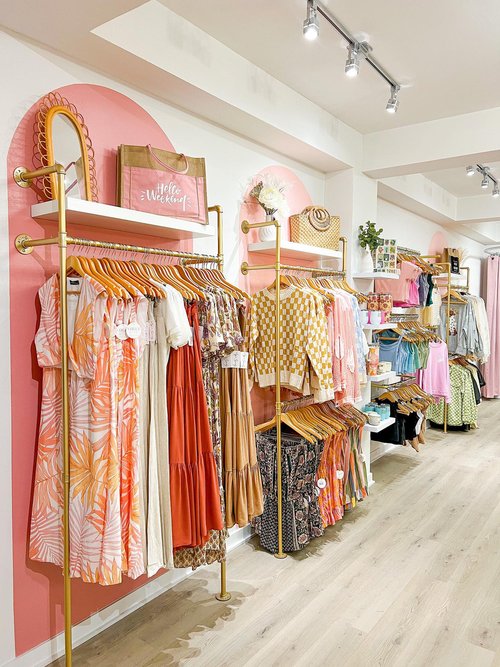Leading 10 Must-Have Pieces from Your Favorite Boutique Fashion Shops
Leading 10 Must-Have Pieces from Your Favorite Boutique Fashion Shops
Blog Article
A Deep Dive Into the Globe of High-Fashion Runways: Understanding Clothes as Art
Developers, a lot like skillful artists, weave intricate narratives through material, color, and form, redefining and testing standard norms appeal standards. As we discover these sartorial eyeglasses, we must ponder: what function does style play in shaping societal worths, and just how does it reflect the ever-changing tapestry of human emotion and identity?
The Development of Runway Shows
The trajectory of path shows has actually changed dramatically over the years, evolving from unique sector events to fascinating eyeglasses that mix style with art. Traditionally, path programs were intimate events, held in ateliers or little locations, largely participated in by purchasers and industry experts. These very early presentations focused on the garments' workmanship and business feasibility, using a functional and straight display screen of seasonal collections.
As the fashion market increased, the nature of runway programs began to change. The 1970s and 1980s noted a transforming factor, with developers looking for to identify themselves through even more staged presentations.
Recently, technology and social media have even more transformed runway shows, making them accessible to an international audience. Livestreaming and electronic systems have democratized style, enabling fanatics worldwide to witness these occasions in real-time (boutique fashion). This evolution reflects a wider social shift, where high-fashion paths act as a dynamic junction of design, efficiency, and development
Designers as Enthusiast Artists
Designers in the high-fashion industry have actually blurred the lines between functional garment production and the theoretical realm of art. By accepting imaginative self-controls such as sculpture, painting, and avant-garde installments, developers craft garments that challenge traditional style standards and raise them to art kinds.
Visionary developers attract ideas from a myriad of sources, including abstract art, historical referrals, and personal stories. They have a distinct capability to picture and emerge concepts that push the boundaries of standard fashion, typically redefining visual standards while doing so. This creative ingenuity is showcased with significant shapes, ingenious materials, and detailed workmanship, which welcome visitors to experience style as even more than just wearable items.
In addition, the path functions as a canvas for these artists, where lights, songs, and set layout coalesce to develop immersive experiences. These discussions are not simply display screens of clothing however are managed efficiencies that stimulate emotion and provoke idea, affirming the designer's role as a real artist in the contemporary cultural landscape.
Social Impacts in vogue
Cultural tapestry weaves its elaborate patterns right into the material of fashion, affecting developers globally. The vibrant interchange of social stories, traditions, and symbols notifies and inspires collections that grace high-fashion paths. Developers meticulously draw from their heritage or engage with cultures distinct from their very own, crafting garments that function as visual narratives. This social dialogue not just enriches the visual diversity but additionally cultivates a deeper understanding and gratitude of global identities.
The influence of society on fashion is usually seen in the reinterpretation of traditional garments and patterns. The use of Japanese bathrobes, Indian saris, or African prints in modern style mirrors a mix of social authenticity and modern aesthetics. Designers such as Valentino's Pierpaolo Piccioli and Alexander McQueen's Sarah Burton have actually been known to integrate rich cultural themes into their couture collections, translating background into wearable art.

Development in Textile and Layout
Development in textile and style constantly improves the landscape of high-fashion, pushing boundaries and redefining possibilities. Over the last few years, technical improvements have dramatically added to this evolution, presenting materials that challenge conventional understandings. Textiles ingrained with clever fibers, efficient in transforming color or regulating temperature level, are no visit this site longer constrained to the realm of scientific research fiction. Designers are increasingly checking out the combination of technology, such as 3D printing, which enables for the production of complex structures that were formerly unthinkable.
Moreover, sustainability has actually become a critical style in textile innovation. The apparel industry is seeing a surge in using green materials, originated from recycled plastics, organic fibers, and even biodegradable parts. These advancements not only provide brand-new appearances and aesthetic appeals yet additionally address important environmental concerns. Designers are accepting these materials to craft garments that are both visually striking and aware of their eco-friendly impact.
In terms of style, avant-garde silhouettes and experimental kinds are constantly changing the runway. By including advanced methods and unconventional materials, developers cultivate garments that obscure the line in between fashion and art, setting new standards for creativity and expression in the high-fashion ball.
Impact of Style on Society
Fashion possesses a profound impact on society, offering as both a representation of cultural identity and a catalyst for social adjustment (boutique fashion). With its advancement, style has mirrored social changes, encapsulating the zeitgeist of different ages.
Furthermore, fashion has the power to bridge social voids, fostering understanding and gratitude amongst varied groups. As globalisation speeds up, the cross-cultural exchange of style ideas becomes significantly substantial, advertising inclusivity and variety. The surge of streetwear, originating from city subcultures, highlights how style can transcend socio-economic limits, approving people a method of self-expression and empowerment.
Essentially, fashion is not simply regarding visual appeals; it is a dynamic force that influences worths, attitudes, and societal progression (boutique fashion). By constantly engaging with cultural and social currents, style continues to check out here be an important component of the collective human experience

Verdict
Designers, similar to visionary musicians, manage collections that mirror identity, feeling, and cultural narratives, testing traditional looks. This intersection of fashion and virtuosity not only captivates audiences around the world but likewise influences social assumptions and advertises a deeper recognition for cultural variety.

Social tapestry weaves its complex patterns into the material of style, influencing developers internationally.Style possesses an extensive impact on society, serving as both a representation of social identification and a driver for social change.
Report this page